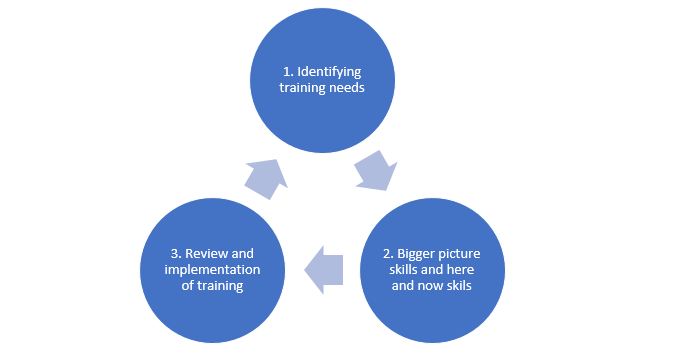Building on you and your staff - Investing time and resource in development
29 January 2019
We have all been guilty of it: that training course you registered for months ago has crept up on you and you are now saying to yourself “I could do without this”; today is that free course you’d booked on to and are now thinking about cancelling at the last minute. However, selecting the right training for your own or your staff’s development journey is critical to the success of your business.
In this blog Matt Richardson, leadership and workforce development advisor, discusses the training development cycle and the initial training selection process.
Identifying training needs
The first stage is to identify training needs. This can be done through a skills matrix, like the one here or by using job descriptions for each role to highlight strengths and areas of development. This will help you to focus on development areas with an individual or within your team.
The skills matrix is also a good tool to help your recruitment strategy when identifying talent and areas within staffing for development. Staff can be asled to complete it as a self-reflective exercise, which is then reviewed by line management to see how it corresponds. Skills matrices can be created in many different ways, but you need to make sure that the topics or subject areas are relevant, that each matrix is as detailed as you need (you may want to leave out “ability to make a good cup of tea”). This can then help with accountability and relevance of training against employee’s job roles.

Bigger picture skills and here and now skills
When I'm looking at training or development opportunities, I split them into two areas. This is the second stage of the cycle, bigger picture skills and here and now skills.
Bigger picture skills are where I may not have an invested interest in or a specific need for training at the time, but know that accessing development in this area will help me in the medium to long term.
Best practice point - bigger picture skills could be the following: an apprenticeship; management training for non-managers; how to manage budgets; general financial management; more experience-based training like observing interviews with new staff or sitting in on management meetings to see how they are conducted.
All of the above can aid development when staff are ready to take on a new role, but also from a management perspective, you are able to see how that employee adapts to these situations and learnings. In performance reviews or supervisions, encourage staff to be honest and ask questions regarding their development within the business, areas they think they can improve and see how that corresponds with your assessment. Managers should be prepared to give feedback, using the skills matrix as cues for discussion to work with your employees to create a development plan to help them achieve their goals.
Here and now skills are development topics that support you in your role right now, whether that be an enhancement of current skill set or learning different methodologies to help you manage specific tasks and/or workflow. For example, I am very prescriptive in my organisation, so investing time in my own development is important to me. One area I am looking to improve is my use of LinkedIn. LinkedIn can be extremely helpful for me within my role; speaking with new and existing clients, sharing useful content/articles and finding out the latest developments in my areas of work. So, I’ve identified my skills gap is a here and now skill for me as I know this will help me in my role and can see the benefits straight away. My next step is to have a look around for training or resources - some you might wish to consider are:
https://alison.com/ - Alison has lots of free training on specific subjects and varies in learning time depending on how far you want to delve into the subject.
YouTube – Certainly, a time efficient way of accessing the skills you need. There are hundreds of videos and even specific channels that support learning on a specific
GC Business Growth Hub events page – This is a great resource to find local workshops, training and events and is updated regularly.
Review and implementation of training
Reviewing the training you have accessed is important, as it will shape your decision-making when future training opportunities present themselves. Looking at the summary of the course before you booked on, did it cover what you needed? How much more time did you need to invest after the training to reach your learning objectives? Would you recommend to your colleagues? These simple questions can help to make the training process much more effective.
You can even take a further step back in the identification process, asking questions like: was I detailed enough in areas I would like to develop? What are the key functions that will help me in my role? What you don’t want to be doing is wasting time attending or completing training and accessing videos that don’t cover what you need: be specific.

From a wider business perspective, it’s important to share learning where appropriate.
Best practice point - staff who attend training are to open the next team meeting by reviewing the training they have attended and explain where useful resources can be found e.g. shared drive, learning folder. This means a local resource bank is being built, which can become a great induction resource for new employees to the business.
The worst kept secret... your employees might not want to stay with your business long-term (sorry business owners). Statistics show that on average, UK employees between the ages of 18-40 stay at a business for between two and three years before looking for new opportunities.
Not offering training or development opportunities within your organisation is unattractive to a potential new recruit and can also demotivate staff you already have. Having time and resources being invested into your development can be extremely motivating. Yes, these staff may end up moving on with the new skills they have learnt, but that should be taken as a positive that you have aided in their development.

Matthew Richardson , Leadership and Workforce Development Advisor
Matt has over 10 years’ experience of working in both the health and charity sectors to improve systematic change in behaviour towards community and workforce development. Matt now works within the Leadership and Workforce Development Team, whilst supporting the Business Growth Hub and Combined Authorities Inclusive Growth agenda. Matt has experience of running nationwide health improvement programmes and in 2015 worked in partnership with the World Health Organisation to create the world’s first British Sign Language version of the Alcohol AUDIT screening tool.
Contact Matt at matthew.richardson@growthco.uk or via LinkedIn.